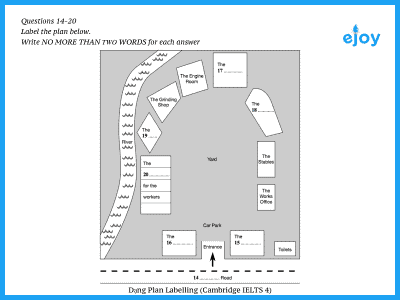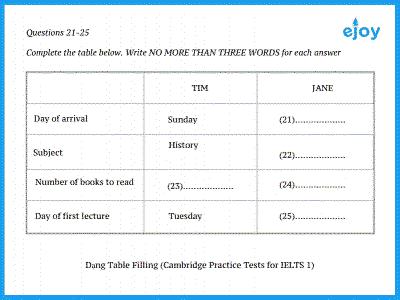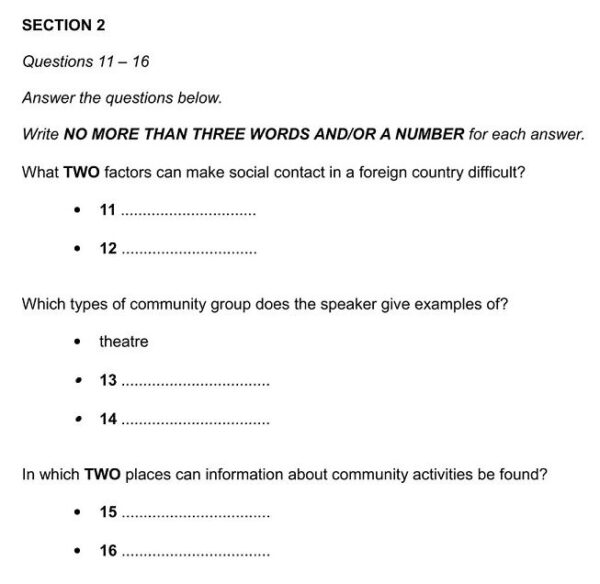
IELTS Listening Test is the first part of the IELTS exam. The duration for IELTS Listening Test is almost 30 minutes. The test format consists of 4 sections and a total of 40 questions are asked in the exam.
A variety of tasks are used in IELTS listening that is chosen from the following types:
First of all, you need to understand the test format so that you can start preparing accordingly for the exam. Before we start discussing the ways to get a good score in the IELTS listening test, let’s discuss some of the salient features of this test.
The IELTS Listening section of both, IELTS Academic and IELTS General Training will be the same. The candidates will get a band score of IELTS listening post the completion of the test. The band score varies from 0 (lowest) to 9 (highest). The aspirants will also receive a combined score in all four sections, which are Listening, Reading, Writing, and Speaking. They will get 1 mark for every correct response.
The IELTS 9 band scale is used for calculating the overall score of the candidates in IELTS General Training and IELTS Academic. The examiners test the listening ability and understanding of the language of the candidates.
Determining Factors
| Factors | Details |
| Total Number of Questions | 40 |
| Marking | One mark for every correct response |
| IELTS Band Scale | 1- Lowest and 9-Highest |
The certified markers who mark the test regularly monitor it to ensure reliability. The Cambridge Assessment English analyses the answer sheet carefully after the completion of marking. A band score conversion table is made for various versions of the listening test. The raw score out of 40 gets converted into 9 band scale. The aspirants will get one mark for every correct response.
| Band score | Raw score out of 40 |
| 5 | 16 |
| 6 | 23 |
| 7 | 30 |
| 8 | 35 |
In the offline IELTS exam, the four sections including Reading, Listening, and Writing are asked. However, the speaking test will be organized by a trained IELTS examiner through a face-to-face interview.
The main differences between computer-based and paper-based IELTS formats are detailed below:
The Paper-based IELTS comes with an answer sheet and a pencil for writing. The candidates are supposed to write answers on this sheet within the given time. While in an online IELTS test, the test takers have to type answers in their respective boxes on the screen. The students will get a pencil or pen and some paper to make notes in this format. The computer test can be tailored for one having some basic typing abilities.
Similar to the paper-based IELTS examination, the online IELTS also starts with Listening, followed by the Reading and Writing tests. The Speaking test will be conducted on the same day before or after the computer-based examination.
In the paper-based IELTS format, the candidates are supposed to write answers in the question booklet while hearing the recording. They get 10 minutes towards the end for transferring the answers to the official answer sheet. The candidates have to type their answers in suitable boxes on the screen in the computer-based format. They will get some time in between the parts for examining answers, but no extra time will be provide at the end.
The paper-based IELTS exams are conducted in spacious rooms, maybe at educational institutions and universities. The online IELTS tests are custom-tailored and conducted in smaller rooms as well.
The IELTS Listening test remains the same for both the IELTS Academic test and the IELTS General Training test. The test takers are supposed to answer 40 questions in response to four recordings. The test takers will listen to four recordings which are a mixture of monologues and conversations from a range of native speakers. Make sure to listen to all the recordings carefully as you will hear each recording once. A total of 10 questions for each part will be asked in the Listening test.
The Kind of IELTS Listening Questions Asked in the Test Includes:
Multiple Choices
In MCQs, the candidates have to choose one correct answer (A, B, or C), you will be given:

[Source – https://www.ieltsjacky.com/types-of-ielts-listening-questions.html]
In the first one, a Short Answer Multiple Choice Question will be asked. It consists of a question and some answers for you to choose from.
Have a look at the example mentioned underneath:

The second kind of IELTS Listening consists of Completion of Sentence – Multiple Choice Question. The starting of the sentence follows a question with 3 possible answers. The students need to choose any 1.

Matching
The candidates have to match a numbered list of items from what they have listened in the listening audio to a set of options on the question paper. The set of options might have some criteria of some kind.
These types of questions are added to assess the candidates’ listening skills for detail and whether they can understand the information provided in a conversation related to a regular topic, like identifying various types of schools or colleges. It also assesses the individual’s ability to follow a conversation between two people and is used to assess relationships’ ability and interrelation between facts in the listening text.

PLAN/DIAGRAM LABELLING/MAP
In this task, the candidate has to fill the labels on a plan (e.g. of a monument), map (for instance a part of a village), or an image (an item’ piece). The candidates can choose their answers from the mentioned question papers. This matching task assesses the individuals’ ability to understand, for example, a description of a place, and to relate this to a visual representation.
Plan Labeling
This kind is related to completing a plan (e.g. of a factory), a map (e.g. of a state area), or an image (e.g. a part of a device). There will be some answers to select. The content of the listening recordings is mostly non-academic. In many cases, the candidates are provided with an introduction about an event or about the structure, or the plan of a building (for example a trip to a museum, gallery, school…)
Example:

Map labeling
The second kind is Map Labeling. There are several places like a hospital, factory, and park… and the candidates have to carefully listen to the recording, look at the given map and label all the gaps in that map.
This kind of question aims at testing the listening and imagination skills on the map of a particular place. Therefore, the ability to obtain spatial language is of utmost importance for you to complete this task.
Example:

Diagram Labeling
The third and also the last format in IELTS listening questions is Diagram Labeling. It will give you a diagram that can demonstrate the parts of a machine, or phases of a process. The speaker in the recording will provide details about the diagram very clearly and logically so that the listeners can easily understand the same. As a result, it is important to keep a close track of what you hear, not what you think of from your own knowledge regarding the provided machine or process.
Example:

Form, note, table, flowchart, summary completion
In this completion task, you have to fill in the gaps in an outline of part or all of the listening text. The outline will focus on the primary facts/ideas given in the text. It might be –
A form: It is used for recording factual details like names, addresses, and telephone numbers.
Name: Oliver 1 ……………….
Delivery address: 2 17 …………………. Street, Chester
Postcode: 3 …………………….
Name of item ordered: 4 …………………
Number of items ordered: 5 …………………
A set of notes: It is used for summarizing information with the help of layout presenting different items linked with one another.
Example:

A table: It is beneficial in summarizing information that relates to transparent categories such as location or time.
Example:

A flow-chart: It is used to summarise a process that has clear stages, marking the direction process with the help of arrows.
Example:

Summary paragraph
The candidates have to fill in the gaps in the provided paragraph. Make sure that the answer meets all the requirements like spelling, grammar, and word limit.
Example:

Flowchart Completion
(Source: Official website www.ielts.org)

Sentence Completion
In this sentence completion task, the test takers are supposed to read a set of sentences consisting of all the information by either including all the text, or one part of it. The test takers can fill a gap in each sentence using the provided information from the listening text. Also take care of the given word limit, for instance, ‘NO MORE THAN ONE WORD AND/OR A NUMBER.
You must read all the instructions carefully as the required words differ. A word limit is provided, for example, ‘NO MORE THAN TWO WORDS AND/OR A NUMBER. If you use more than the word limit, the answer written by you will be considered incorrect, so always check the word limit required for every question. Words like ‘police-man’ “swimwear” etc. will be considered a single word.

Sentence completion mainly focuses on the individuals’ ability to identify the main information in a listening text. It is crucial to understand functional relationships like cause and effect.
Source: Official websitewww.ieltsessentials.com
Table Completion

Short-answer questions
In the short-answer question type, the test takers have to read a question and then write a short answer with the facts provided during the listening. Many times the aspirants are presented with a question that asks them to list two or three points.
A word limit will be provided, for instance, ‘NO MORE THAN THREE WORDS AND/OR A NUMBER. If you use more than the required word limit, the answer will be taken as incorrect.
[Source: Official website www.ieltsessentials.com]

The IELTS Listening test consists of 4 sections with 10 questions each in every section. The questions are designed in a way that all the answers will appear in the same order the candidates heard in the audio. The duration of the test is 30 minutes, and in these minutes, the students will listen and have to answer at the same time. The candidates can write or circle their answers and draft them in the question booklet.
Thus, it is important to make a well-defined plan, follow it strictly and try to work hard to fulfil your dream. During the given 40 minutes of listening time, one needs to stay really focused, for the same practice is very important. For every correct answer, candidates will get 1 point. Therefore, the best advice in case you have limited time is that instead of doing long question, do easy ones first. And the meaning of right here is spelling, grammar, and word limit as well.
In conclusion, when it comes to studying a skill, it is imperative to know what to learn before knowing how to learn. It means that one of the tips to get a good score in IELTS Listening is to know all the kinds of questions asked in the exam.
So to make it clear, we are discussing some of the tips that can help you score good marks on the IELTS listening test.